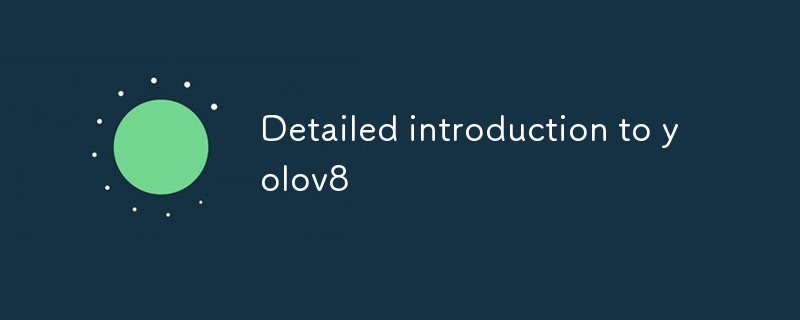Home >Technology peripherals >AI >Detailed introduction to yolov8
Detailed introduction to yolov8
- DDDOriginal
- 2024-08-15 11:48:23952browse
YOLOv8, an advanced object detection algorithm, introduces architectural improvements like CSP, SAM, PAN, and an improved label assignment algorithm. Enhanced training techniques include anchor-free training, data augmentation, transformer layers, an

YOLOv8 Introduction and Comprehensive Explanation
What are the significant architectural improvements introduced in YOLOv8 compared to previous versions?
YOLOv8, the latest iteration of the You Only Look Once (YOLO) object detection algorithm, introduces several significant architectural improvements over its predecessors:
- Cross-Stage Partial Connections (CSP): CSP reuses feature maps across different stages of the network, reducing computational complexity and improving accuracy.
- Spatial Attention Module (SAM): SAM focuses on important spatial regions, enhancing the detection of small objects and resolving feature ambiguity.
- Path Aggregation Network (PAN): PAN fuses features from different network stages, providing richer context for object detection.
- Label Assignment Algorithm: The improved label assignment algorithm assigns labels more precisely, resulting in better training stability and accuracy.
- Bag-of-Freebies: A collection of non-trainable augmentation techniques, including mosaics, mixup, and adaptive anchor boxes, further boosts accuracy without adding computational cost.
How does YOLOv8 leverage training techniques to enhance object detection accuracy and speed?
YOLOv8 employs various training techniques to optimize performance:
- Anchor-Free Training: YOLOv8 removes anchors during training, reducing the sensitivity to anchor size and improving accuracy, especially for small objects.
- Data Augmentation: Extensive data augmentation techniques, including Mixup, CutMix, Mosaic, and RandBN, augment the training dataset, increasing robustness and handling diverse input conditions.
- Transformer Layers: The integration of transformer layers enhances feature representation, improving object detection precision and class discrimination.
- Efficient Training Pipeline: YOLOv8 optimizes the training pipeline for faster convergence and improved accuracy, using techniques like SimOTA, SWA, and learning rate warm-up.
What are the real-world applications and performance benchmarks of YOLOv8 in various domains?
YOLOv8 has wide-ranging applications, including:
- Object Detection: Detecting objects in images or videos, such as pedestrians, vehicles, or animals.
- Real-Time Monitoring: Object detection in real-time scenarios, such as traffic monitoring, security surveillance, or crowd management.
- Autonomous Driving: Object detection for lane detection, obstacle avoidance, and pedestrian recognition on self-driving vehicles.
In benchmarks against other object detectors:
- Accuracy: YOLOv8 achieves state-of-the-art accuracy on popular datasets, such as COCO, PASCAL VOC, and ImageNet.
- Speed: YOLOv8 maintains high accuracy while achieving fast inference time, making it suitable for real-time applications.
- Versatility: YOLOv8 outperforms competitors in various application areas, demonstrating its versatility and effectiveness.
The above is the detailed content of Detailed introduction to yolov8. For more information, please follow other related articles on the PHP Chinese website!
Related articles
See more- Technology trends to watch in 2023
- How Artificial Intelligence is Bringing New Everyday Work to Data Center Teams
- Can artificial intelligence or automation solve the problem of low energy efficiency in buildings?
- OpenAI co-founder interviewed by Huang Renxun: GPT-4's reasoning capabilities have not yet reached expectations
- Microsoft's Bing surpasses Google in search traffic thanks to OpenAI technology

